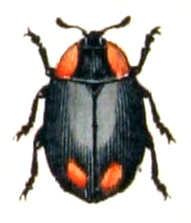Features
Adults
The adult beetles of Scymnini are small, typically one or two millimeters long. Their body is hemispherically domed and is almost always covered with dense hair. Only a few species have a smooth and glossy back surface. Many species can be identified by their characteristic pattern and their size, however examination under a microscope is usually needed.
The Scymnini like the Chilocorini show their head well below the prothorax (pronotum). Their very short probes are built differently and have a reduced number of members. The Chilocorini differ from the Scymnini by their greatly expanded endplates ( clypeus ).
Larvae
The larvae of Scymnini secrete a white, waxy substance, which their body is covered with. Exceptions are only seen in the species of the genus Stethorus who have no such guard formations. On the other hand, there are wax coatings also in the larvae of other tribes of ladybugs, z. B. in Coccidulini and Chilocorini. [1] The larvae have also been known for forming small congregations of their own species, leaving a white smudge on the surface they are on.
This page is based on this
Wikipedia article Text is available under the
CC BY-SA 4.0 license; additional terms may apply.
Images, videos and audio are available under their respective licenses.










